Junyuan Shang
Inner Thinking Transformer: Leveraging Dynamic Depth Scaling to Foster Adaptive Internal Thinking
Feb 19, 2025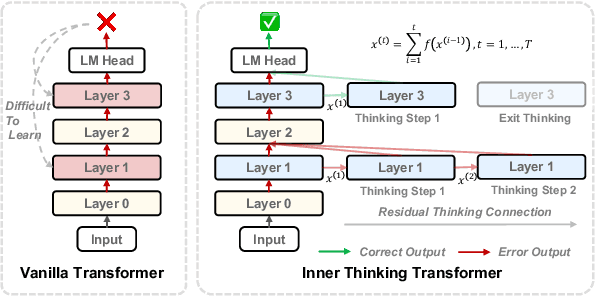
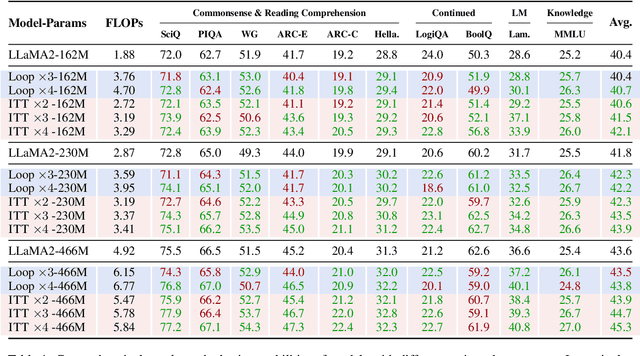
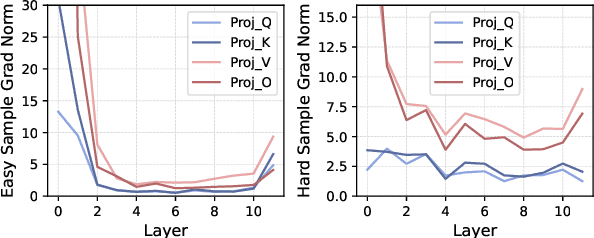
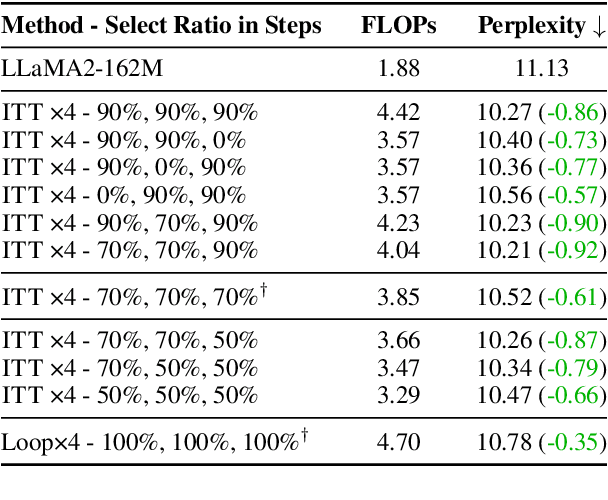
Abstract:Large language models (LLMs) face inherent performance bottlenecks under parameter constraints, particularly in processing critical tokens that demand complex reasoning. Empirical analysis reveals challenging tokens induce abrupt gradient spikes across layers, exposing architectural stress points in standard Transformers. Building on this insight, we propose Inner Thinking Transformer (ITT), which reimagines layer computations as implicit thinking steps. ITT dynamically allocates computation through Adaptive Token Routing, iteratively refines representations via Residual Thinking Connections, and distinguishes reasoning phases using Thinking Step Encoding. ITT enables deeper processing of critical tokens without parameter expansion. Evaluations across 162M-466M parameter models show ITT achieves 96.5\% performance of a 466M Transformer using only 162M parameters, reduces training data by 43.2\%, and outperforms Transformer/Loop variants in 11 benchmarks. By enabling elastic computation allocation during inference, ITT balances performance and efficiency through architecture-aware optimization of implicit thinking pathways.
Mixture of Hidden-Dimensions Transformer
Dec 10, 2024



Abstract:Transformer models encounter challenges in scaling hidden dimensions efficiently, as uniformly increasing them inflates computational and memory costs while failing to emphasize the most relevant features for each token. For further understanding, we study hidden dimension sparsity and observe that trained Transformers utilize only a small fraction of token dimensions, revealing an "activation flow" pattern. Notably, there are shared sub-dimensions with sustained activation across multiple consecutive tokens and specialized sub-dimensions uniquely activated for each token. To better model token-relevant sub-dimensions, we propose MoHD (Mixture of Hidden Dimensions), a sparse conditional activation architecture. Particularly, MoHD employs shared sub-dimensions for common token features and a routing mechanism to dynamically activate specialized sub-dimensions. To mitigate potential information loss from sparsity, we design activation scaling and group fusion mechanisms to preserve activation flow. In this way, MoHD expands hidden dimensions with negligible increases in computation or parameters, efficient training and inference while maintaining performance. Evaluations across 10 NLP tasks show that MoHD surpasses Vanilla Transformers in parameter efficiency and task performance. It achieves 1.7% higher performance with 50% fewer activation parameters and 3.7% higher performance with a 3x parameter expansion at constant activation cost. MOHD offers a new perspective for scaling the model, showcasing the potential of hidden dimension sparsity to boost efficiency
MoR: Mixture of Ranks for Low-Rank Adaptation Tuning
Oct 17, 2024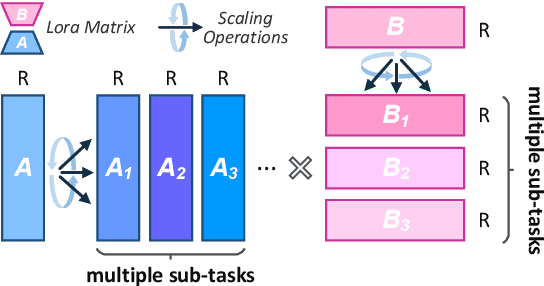
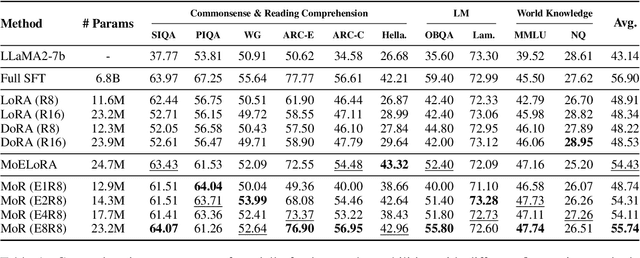

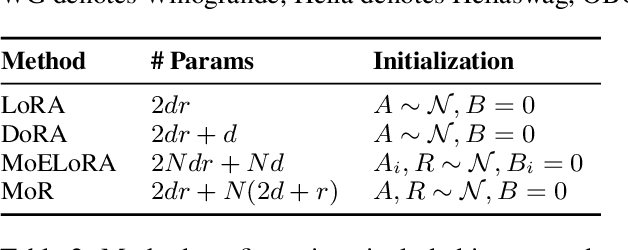
Abstract:Low-Rank Adaptation (LoRA) drives research to align its performance with full fine-tuning. However, significant challenges remain: (1) Simply increasing the rank size of LoRA does not effectively capture high-rank information, which leads to a performance bottleneck.(2) MoE-style LoRA methods substantially increase parameters and inference latency, contradicting the goals of efficient fine-tuning and ease of application. To address these challenges, we introduce Mixture of Ranks (MoR), which learns rank-specific information for different tasks based on input and efficiently integrates multi-rank information. We firstly propose a new framework that equates the integration of multiple LoRAs to expanding the rank of LoRA. Moreover, we hypothesize that low-rank LoRA already captures sufficient intrinsic information, and MoR can derive high-rank information through mathematical transformations of the low-rank components. Thus, MoR can reduces the learning difficulty of LoRA and enhances its multi-task capabilities. MoR achieves impressive results, with MoR delivering a 1.31\% performance improvement while using only 93.93\% of the parameters compared to baseline methods.
BiPC: Bidirectional Probability Calibration for Unsupervised Domain Adaption
Sep 29, 2024Abstract:Unsupervised Domain Adaptation (UDA) leverages a labeled source domain to solve tasks in an unlabeled target domain. While Transformer-based methods have shown promise in UDA, their application is limited to plain Transformers, excluding Convolutional Neural Networks (CNNs) and hierarchical Transformers. To address this issues, we propose Bidirectional Probability Calibration (BiPC) from a probability space perspective. We demonstrate that the probability outputs from a pre-trained head, after extensive pre-training, are robust against domain gaps and can adjust the probability distribution of the task head. Moreover, the task head can enhance the pre-trained head during adaptation training, improving model performance through bidirectional complementation. Technically, we introduce Calibrated Probability Alignment (CPA) to adjust the pre-trained head's probabilities, such as those from an ImageNet-1k pre-trained classifier. Additionally, we design a Calibrated Gini Impurity (CGI) loss to refine the task head, with calibrated coefficients learned from the pre-trained classifier. BiPC is a simple yet effective method applicable to various networks, including CNNs and Transformers. Experimental results demonstrate its remarkable performance across multiple UDA tasks. Our code will be available at: https://github.com/Wenlve-Zhou/BiPC.
NACL: A General and Effective KV Cache Eviction Framework for LLMs at Inference Time
Aug 07, 2024Abstract:Large Language Models (LLMs) have ignited an innovative surge of AI applications, marking a new era of exciting possibilities equipped with extended context windows. However, hosting these models is cost-prohibitive mainly due to the extensive memory consumption of KV Cache involving long-context modeling. Despite several works proposing to evict unnecessary tokens from the KV Cache, most of them rely on the biased local statistics of accumulated attention scores and report performance using unconvincing metric like perplexity on inadequate short-text evaluation. In this paper, we propose NACL, a general framework for long-context KV cache eviction that achieves more optimal and efficient eviction in a single operation during the encoding phase. Due to NACL's efficiency, we combine more accurate attention score statistics in PROXY TOKENS EVICTION with the diversified random eviction strategy of RANDOM EVICTION, aiming to alleviate the issue of attention bias and enhance the robustness in maintaining pivotal tokens for long-context modeling tasks. Notably, our method significantly improves the performance on short- and long-text tasks by 80% and 76% respectively, reducing KV Cache by up to 50% with over 95% performance maintenance. The code is available at https: //github.com/PaddlePaddle/Research/ tree/master/NLP/ACL2024-NACL.
DHA: Learning Decoupled-Head Attention from Transformer Checkpoints via Adaptive Heads Fusion
Jun 03, 2024



Abstract:Large language models (LLMs) with billions of parameters demonstrate impressive performance. However, the widely used Multi-Head Attention (MHA) in LLMs incurs substantial computational and memory costs during inference. While some efforts have optimized attention mechanisms by pruning heads or sharing parameters among heads, these methods often lead to performance degradation or necessitate substantial continued pre-training costs to restore performance. Based on the analysis of attention redundancy, we design a Decoupled-Head Attention (DHA) mechanism. DHA adaptively configures group sharing for key heads and value heads across various layers, achieving a better balance between performance and efficiency. Inspired by the observation of clustering similar heads, we propose to progressively transform the MHA checkpoint into the DHA model through linear fusion of similar head parameters step by step, retaining the parametric knowledge of the MHA checkpoint. We construct DHA models by transforming various scales of MHA checkpoints given target head budgets. Our experiments show that DHA remarkably requires a mere 0.25\% of the original model's pre-training budgets to achieve 97.6\% of performance while saving 75\% of KV cache. Compared to Group-Query Attention (GQA), DHA achieves a 5$\times$ training acceleration, a maximum of 13.93\% performance improvement under 0.01\% pre-training budget, and 4\% relative improvement under 0.05\% pre-training budget.
X-PuDu at SemEval-2022 Task 7: A Replaced Token Detection Task Pre-trained Model with Pattern-aware Ensembling for Identifying Plausible Clarifications
Nov 27, 2022Abstract:This paper describes our winning system on SemEval 2022 Task 7: Identifying Plausible Clarifications of Implicit and Underspecified Phrases in Instructional Texts. A replaced token detection pre-trained model is utilized with minorly different task-specific heads for SubTask-A: Multi-class Classification and SubTask-B: Ranking. Incorporating a pattern-aware ensemble method, our system achieves a 68.90% accuracy score and 0.8070 spearman's rank correlation score surpassing the 2nd place with a large margin by 2.7 and 2.2 percent points for SubTask-A and SubTask-B, respectively. Our approach is simple and easy to implement, and we conducted ablation studies and qualitative and quantitative analyses for the working strategies used in our system.
ERNIE 3.0 Titan: Exploring Larger-scale Knowledge Enhanced Pre-training for Language Understanding and Generation
Dec 23, 2021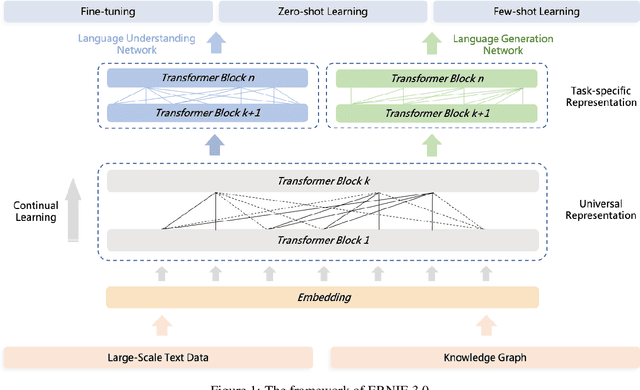

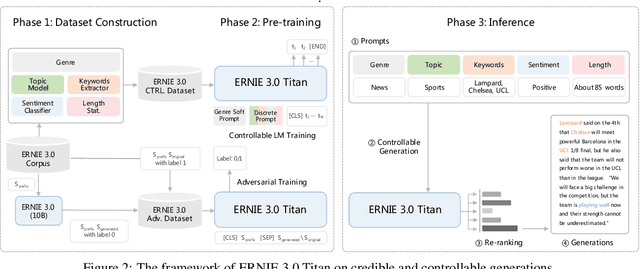
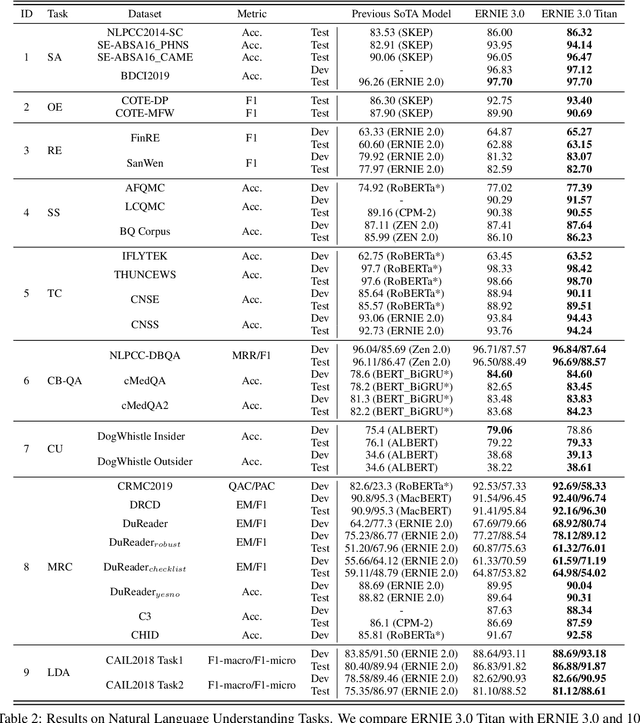
Abstract:Pre-trained language models have achieved state-of-the-art results in various Natural Language Processing (NLP) tasks. GPT-3 has shown that scaling up pre-trained language models can further exploit their enormous potential. A unified framework named ERNIE 3.0 was recently proposed for pre-training large-scale knowledge enhanced models and trained a model with 10 billion parameters. ERNIE 3.0 outperformed the state-of-the-art models on various NLP tasks. In order to explore the performance of scaling up ERNIE 3.0, we train a hundred-billion-parameter model called ERNIE 3.0 Titan with up to 260 billion parameters on the PaddlePaddle platform. Furthermore, we design a self-supervised adversarial loss and a controllable language modeling loss to make ERNIE 3.0 Titan generate credible and controllable texts. To reduce the computation overhead and carbon emission, we propose an online distillation framework for ERNIE 3.0 Titan, where the teacher model will teach students and train itself simultaneously. ERNIE 3.0 Titan is the largest Chinese dense pre-trained model so far. Empirical results show that the ERNIE 3.0 Titan outperforms the state-of-the-art models on 68 NLP datasets.
ERNIE 3.0: Large-scale Knowledge Enhanced Pre-training for Language Understanding and Generation
Jul 05, 2021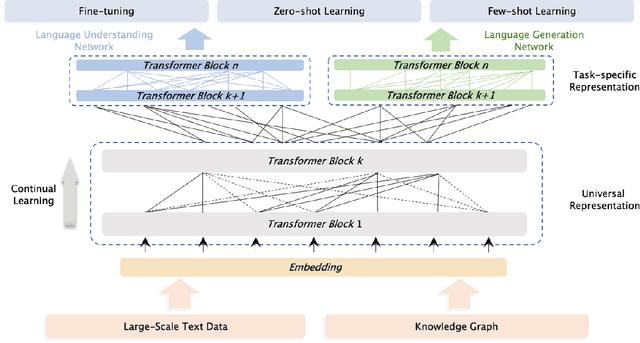

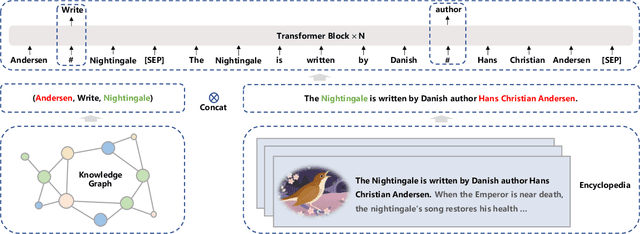
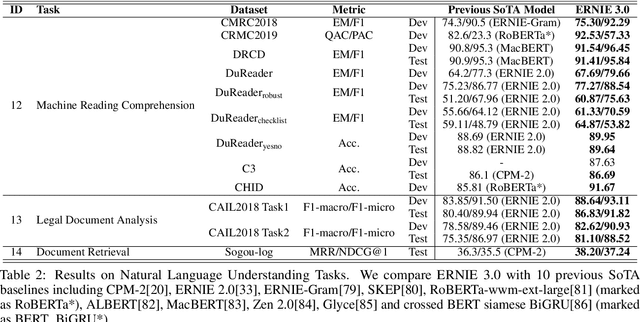
Abstract:Pre-trained models have achieved state-of-the-art results in various Natural Language Processing (NLP) tasks. Recent works such as T5 and GPT-3 have shown that scaling up pre-trained language models can improve their generalization abilities. Particularly, the GPT-3 model with 175 billion parameters shows its strong task-agnostic zero-shot/few-shot learning capabilities. Despite their success, these large-scale models are trained on plain texts without introducing knowledge such as linguistic knowledge and world knowledge. In addition, most large-scale models are trained in an auto-regressive way. As a result, this kind of traditional fine-tuning approach demonstrates relatively weak performance when solving downstream language understanding tasks. In order to solve the above problems, we propose a unified framework named ERNIE 3.0 for pre-training large-scale knowledge enhanced models. It fuses auto-regressive network and auto-encoding network, so that the trained model can be easily tailored for both natural language understanding and generation tasks with zero-shot learning, few-shot learning or fine-tuning. We trained the model with 10 billion parameters on a 4TB corpus consisting of plain texts and a large-scale knowledge graph. Empirical results show that the model outperforms the state-of-the-art models on 54 Chinese NLP tasks, and its English version achieves the first place on the SuperGLUE benchmark (July 3, 2021), surpassing the human performance by +0.8% (90.6% vs. 89.8%).
ERNIE-DOC: The Retrospective Long-Document Modeling Transformer
Dec 31, 2020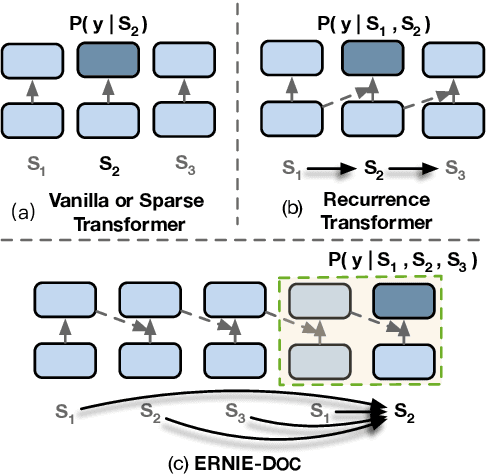
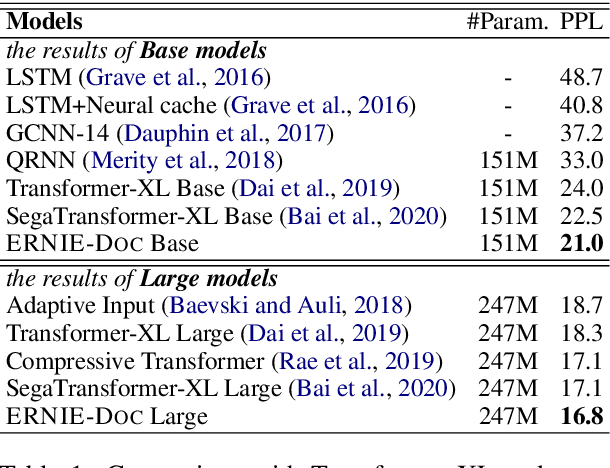
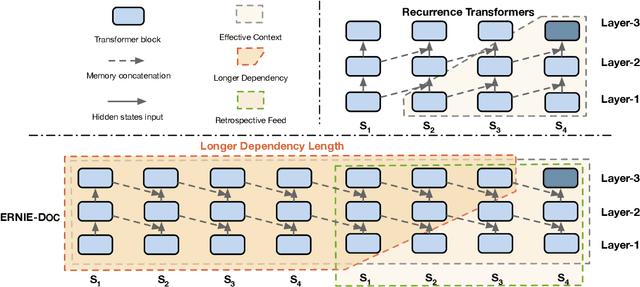

Abstract:Transformers are not suited for processing long document input due to its quadratically increasing memory and time consumption. Simply truncating a long document or applying the sparse attention mechanism will incur the context fragmentation problem or inferior modeling capability with comparable model size. In this paper, we propose ERNIE-DOC, a document-level language pretraining model based on Recurrence Transformers. Two well-designed techniques, namely the retrospective feed mechanism and the enhanced recurrence mechanism enable ERNIE-DOC with much longer effective context length to capture the contextual information of a whole document. We pretrain ERNIE-DOC to explicitly learn the relationship among segments with an additional document-aware segment reordering objective. Various experiments on both English and Chinese document-level tasks are conducted. ERNIE-DOC achieves SOTA language modeling result of 16.8 ppl on WikiText-103 and outperforms competitive pretraining models on most language understanding tasks such as text classification, question answering by a large margin.
 Add to Chrome
Add to Chrome Add to Firefox
Add to Firefox Add to Edge
Add to Edge